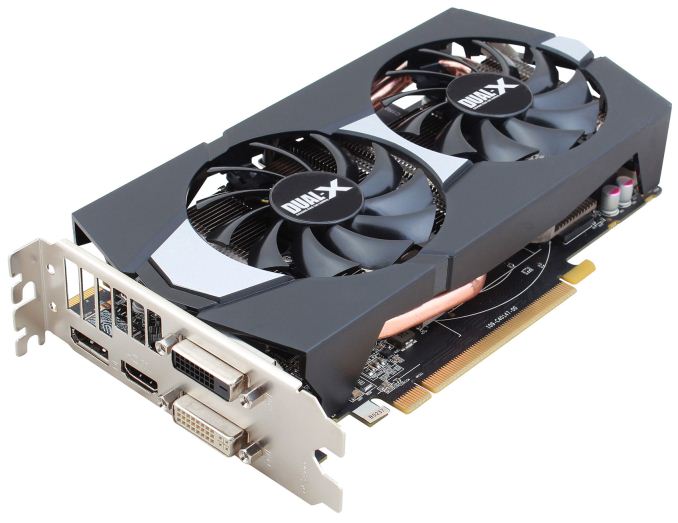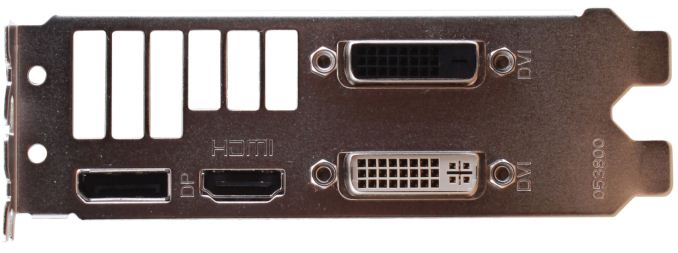The AMD Radeon R7 265 & R7 260 Review: Feat Sapphire & Asus
by Ryan Smith on February 13, 2014 8:00 AM ESTMeet The Sapphire Radeon R7 265
Since the R7 265 is a variant of the existing R7 270 series, AMD isn’t creating a reference card this time around. In lieu of that they have been sending the press Pitcairn cards reprogrammed to the 265 specification, which gives us something suitable to test but doesn’t necessarily represent what the final retail products will look like. For our sample we received a board based on Sapphire’s Radeon R9 270 Dual-X design.
Because we don’t know at this time whether this specific card will be a retail product or not, we’re not in a position to talk about it in depth. But we did want to discuss it briefly, as we expect most (if not all) retail R7 265 cards to be built in a similar manner, especially for the board partners reusing their existing R9 270 designs as was the case here.
Sapphire’s design is fairly typical for a 150W AMD card. Here Sapphire utilizes a compact form of their Dual-X cooler, relying on a pair of 75mm fans mounted over an aluminum heatsink, with a pair of copper heatpipes providing a connection between the heatsink and the Pitcairn GPU underneath. A baseplate brings the package together, providing cooling for the RAM and VRMs, relying on small grooves at various areas to function as a quasi-heatsink and improve convection. This means that it is of course an open air design, and while 150W is not trouble for most cases these days it does bear mentioning.
Sapphire’s Dual-X cooler runs 8.5” long, causing it to slightly overhang the 7.9” PCB. The card doesn’t feature a dedicated stiffening mechanism of any kind, but the baseplate is just large enough to provide the necessary rigidity on its own. Elsewhere the required 6pin PCIe power socket is located at far end of the PCB, orientated parallel to the PCB itself and slightly obscured by the card’s shroud; so you’ll need a bit more room behind the card to work in the necessary power cabling.
Finally, at the front end of the card we find half slot vent, coupled with AMD’s current generation I/O layout of 1x DisplayPort, 1x HDMI, and 2x DL-DVI. Notably, Sapphire has also added themselves to the pool of board partners with this design by using a wider grating spacing in an attempt to improve airflow, subdividing their vent into just 6 relatively large segments.













52 Comments
View All Comments
edzieba - Thursday, February 13, 2014 - link
Are Anandtech considering a switch from average framerates to latency/frame-rating (either with Fraps or FCAT)?Ryan Smith - Thursday, February 13, 2014 - link
Frame pacing is an additional tool we run from time to time as is appropriate, but it's not something we'll use for every review. Frame pacing is largely influenced by drivers and hardware, neither of which shift much on a review-by-review basis. So it's primarily reserved for multi-GPU articles and new architectures as appropriate.And especially in the case of single-GPU setups, there's not much to look at. None of these cards has trouble delivering frames at a reasonably smooth pace.
http://www.anandtech.com/bench/GPU14/873
HisDivineOrder - Thursday, February 13, 2014 - link
Yeah, that's what you guys said before the whole frame latency thing broke, too. It's a shame you aren't doing proper monitoring to catch it the first time and are setting up a scenario where it flies under the radar yet again the next time AMD decides to get lax on making drivers.Then again, this article is in red, right? AMD News is right next to it. Hell, even the comment button is red. I'm guessing the AMD overlords wouldn't like it very much if you were constantly harping on something they dropped the ball on so completely that their competitor had to slowly explain to them how to even see the problem and then how to fix it.
gdansk - Thursday, February 13, 2014 - link
It's a shame. I'm with your argument. AnandTech should try to include as many indicative benchmarks as possible. At times FCAT is indicative.But sadly, calling someone a shill with only coincidence is no better than libel. You have made an unsubstantiated allegation. It is decidedly unscientific to insult one's professional integrity with mere coincidental insinuations and no evidence. Why would you do that?
Death666Angel - Thursday, February 13, 2014 - link
So they are in the pocket of nVidia, Intel, AMD, Android AND Apple? Wow, those companies must really be idiots then.Gigaplex - Thursday, February 13, 2014 - link
I don't know where you got all the other brands from, but technically yes Ars is in the pockets of AMD. See http://www.anandtech.com/portal/amd - this is sponsored by AMD.Gigaplex - Thursday, February 13, 2014 - link
Bah, AnandTech, not ArsDeath666Angel - Thursday, February 13, 2014 - link
I know _that_. But he is clearly insinuating that their opinions are bought by AMD. And since products from all those companies I listed (who are all competitors) regularly get recommendations, and Anandtech gets then accused of being paid shills, I find it funny that anyone thinks that is true. If they are bought by AMD as suggested, how come they don't come up with a benchmark track that makes AMD CPUs shine? Or how come they slammed the R9 so much for the noise? It's all pretty silly.nader_21007 - Friday, February 14, 2014 - link
It seems that it hurts you how come this site is not biased and doesn't admire every thing Nvidia, like other sites? well you can go read Tom's Hardware, WCCFtech and every other hardware site, and be sure they will satisfy your needs.zodiacsoulmate - Friday, February 14, 2014 - link
Yea, it's like trying to compare samsung to apple again, sure you can say there is no way to compare which one is better hardware considered, the user experience is just not on pair...